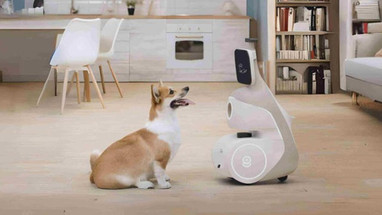17th Jun 2024
How AI is Helping Our Pets
The Impact of AI on Our Pets
As technology continues to evolve, AI is making its mark on the pet industry, offering exciting opportunities Innovations such as smart collars and robotic pet sitters are enhancing the way we care for our furry friends, but they also raise important questions about privacy and the human-animal bond.
AI Companions for Pets
Take Sandeep Sadhu, for example. While he is busy running his construction business, his mini groodle, Simba, is entertained by ORo, a robot that feeds, supervises, trains, and plays with him. "ORo is a fantastic companion for Simba," says Sadhu.
This robot represents a broader trend where AI is becoming an integral part of pet care. From AI-powered cameras that dispense treats to collars that monitor health metrics, technology is transforming the pet industry. In 2023, Americans spent $147 billion on their pets, a significant increase from $90 billion in 2018. By 2030, the global pet market is expected to reach nearly $500 billion.
Health Monitoring Through Smart Accessories
Melanie Rigden, uses a PetPace collar for her mini-Australian labradoodle, Ruby. This smart collar tracks various health metrics such as calories burned, sleep quality, stress levels, and more. "Ruby's health and wellness are always top of mind for me," says Rigden.
PetPace, founded by veterinarian Asaf Dagan in 2012, aims to catch health issues early by monitoring these metrics. "We can identify early signs of illness by detecting abnormal biometric patterns," Dagan explains. The collar's data helps pet owners avoid emergency visits and unnecessary appointments, though it’s not a replacement for regular veterinary care.
Advanced Health Apps
TTcare, a healthcare app for pets, allows owners to upload images of their pets’ eyes, skin, teeth, and joints for an AI analysis of potential health issues. This app, developed in collaboration with veterinary colleges, claims a 93% accuracy rate in diagnosing conditions.
Pet parents are becoming more vigilant about their pets’ health and everyday activities. Apps that analyze canine poop or AI cameras that monitor pets when owners are away are gaining popularity. Petcube, for example, offers cameras with treat dispensers and motion alerts, helping owners keep an eye on their pets remotely.
Translators and AI Interaction
One of the more novel uses of AI in pet care is the development of translators. MeowTalk, an app that translates cat meows into human language, has been downloaded over 22 million times since its launch in 2020. "We aim to strengthen the bond between cats and humans by giving cats a voice," says Olivia Cole, MeowTalk’s director of marketing.
Animal behaviorist Con Slobodchikoff is working on Zoolingua, a dog translator that aims to decode canine signals without relying on human input. He believes this could help reduce behavioral issues and prevent pet abandonment. "We want to foster a deeper, more understanding relationship between people and their pets," he says.
Conclusion
AI has the potential to greatly enhance pet care, from health monitoring to providing companionship. However, it is crucial to balance technological advancements with ethical considerations and the intrinsic bond between humans and their pets. As we continue to integrate AI into our lives, we must ensure that the well-being of our furry friends remains a priority.

